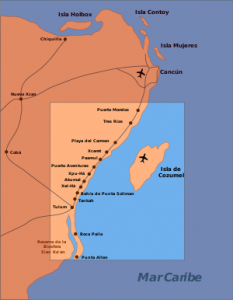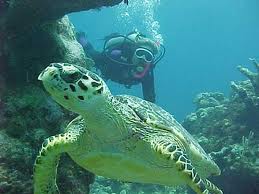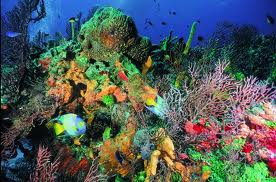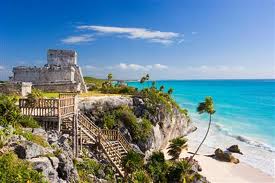Riviera Maya
 Riviera Maya is a tourism district following the coastal Highway 307 which parallels the Caribbean coastline of the Mexican state of Quintana Roo, located on the eastern portion of the Yucatán Peninsula. This district historically started at the city of Playa del Carmen and ended at the village of Tulum, although the towns of Puerto Morelos situated to the north and between Playa del Carmen and Cancun as well as the town of Felipe Carrillo Puerto situated 40 kilometres (25 mi) to the south of Tulum are both currently being promoted as part of the Riviera Maya tourist corridor.
Riviera Maya is a tourism district following the coastal Highway 307 which parallels the Caribbean coastline of the Mexican state of Quintana Roo, located on the eastern portion of the Yucatán Peninsula. This district historically started at the city of Playa del Carmen and ended at the village of Tulum, although the towns of Puerto Morelos situated to the north and between Playa del Carmen and Cancun as well as the town of Felipe Carrillo Puerto situated 40 kilometres (25 mi) to the south of Tulum are both currently being promoted as part of the Riviera Maya tourist corridor.
A major attraction throughout the Riviera Maya are coastal and reef aquatic activities dependent on the coastal water and the Mesoamerican Barrier Reef System (also known as the Belize Barrier Reef) which begins near Cancun and continues along the whole length of the Riviera Maya continuing southward to Guatemala. This barrier reef system is the second longest in the world.
Playa del Carmen (Xaman Ha’ or Pláaya in Modern Maya) is a balneario resort city just south of Cancún on the coast of the Caribbean Sea, in the northeast of the Mexican state of Quintana Roo. The city is the seat of the Solidaridad municipality. In the 2005 census, the city had a population of about 100,383 people and it is rapidly growing in population. It is the third largest city in Quintana Roo, after Cancún and Chetumal.
Originally a small fishing town, tourism to Playa del Carmen began with the passenger ferry service to Cozumel, an island across the Cozumel Channel and world famous scuba diving destination. While passing through, many people realized that it was a nice place to relax away from the crowds of Cancún but with the same quality beaches and turquoise waters. While its salt water scuba diving cannot compete with Cozumel, for the adventurous, Playa del Carmen’s fresh water cenote diving more than makes up for it.
 Cozumel
Cozumel
Beyond the breathtaking waters and ribbons of white sand is a land steeped in rich history and ancient wonders. And at every turn, there is something exciting to discover and explore. From the majestic archeological site in San Gervasio to the rustic, vivid green church in El Cedral, Cozumel has many stories to share. And their origins go back to 300 A.D. when the first Mayans settled on the island. Before there were vacation seekers, there were religious pilgrimages, as many women came to pay homage to the fertility goddess, Ixchel. Through every passing century, Cozumel became one of the most important sanctuaries in the Yucatan region. And the Mayan influence remains today. But that is just the beginning. Let us take you on a guided tour and uncover the magic of the ancient Maya. You’ll soon realize why this is like no other island in the world.
Cozumel is just 30 miles from north to south and 10 miles from east to west, so you can easily explore the island on your visit. But within its sandy borders, there is so much to fall in love with.
On average, the island stays around a blissful 80 degrees. The summers are slightly warmer, ranging in the mid 80s to 90s and the winters cool to the mid 70s. It’s always a beach day in Cozumel, as the water ranges from a warm 77 to 82 degrees throughout the year. Cozumel is home to the largest reef system in the Americas, the Mesoamerican Reef. Teeming with hundreds of tropical fish, turtles and other vibrant sea life, it is truly a diver’s dream. But even if you don’t explore down into the depths of the ocean, there is much to see for snorkelers too. There are as many as 250 different species of tropical fish including the queen angelfish and the illusive toadfish, seen nowhere else in the world.
Above the sparkling surface of the water, the trees are speckled with frigate birds, brown pelicans, olivaceous cormorants and others. If you look closely, you may catch a glimpse of a tree frog, a crocodile or the prehistoric iguana resting in the lush vegetation. But no worries, our locals are the friendliest in the world.
 Tulum (Yucatec: Tulu’um) is the site of a Pre-Columbian Maya walled city serving as a major port for Cobá.The ruins are situated on 12-meter (39 ft) tall cliffs, along the east coast of the Yucatán Peninsula on the Caribbean Sea in the state of Quintana Roo, Mexico.Tulum was one of the last cities inhabited and built by the Mayans, it was at its height between the 13th and 15th centuries and managed to survive about 70 years after the Spanish began occupying Mexico. Old World diseases brought by the Spanish settlers appear to have been the cause of its demise. Tulum remains one of the best-preserved coastal Maya sites.
Tulum (Yucatec: Tulu’um) is the site of a Pre-Columbian Maya walled city serving as a major port for Cobá.The ruins are situated on 12-meter (39 ft) tall cliffs, along the east coast of the Yucatán Peninsula on the Caribbean Sea in the state of Quintana Roo, Mexico.Tulum was one of the last cities inhabited and built by the Mayans, it was at its height between the 13th and 15th centuries and managed to survive about 70 years after the Spanish began occupying Mexico. Old World diseases brought by the Spanish settlers appear to have been the cause of its demise. Tulum remains one of the best-preserved coastal Maya sites.
To find out which resort or hotel will suit you best for your upcoming travel plans to the Riveria Maya, please send us an email or fill out the Contact Form on the right side of this page.



